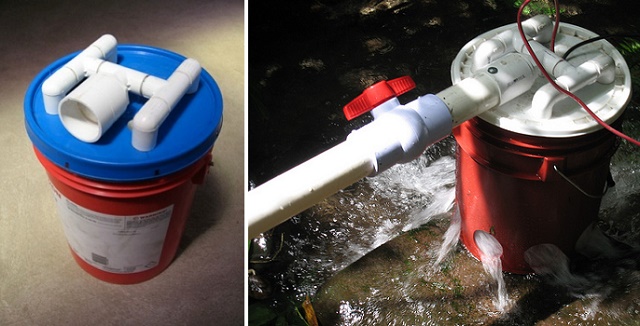With self-sufficiency on the rise in almost every large city, it is common to see people trying to set up their own power or water supply. Recycling is almost a regular thing now so those who want to live really independently choose a hydroelectric generator as their next DIY project to make. Making such a system is quite easy and actually there is no need for a bunch of extra materials to get in order to begin the whole construction phase. A 5-gallon bucket should be your base and the rest will easily fall into place. As you can see from the images, the parts you use should not be hard to get, actually readily available in any location you might be. Follow the instructions from the video tutorial. You are now able to produce small amounts of electricity for your own use. Watch the video and the PDF Tutorial..




















I was extremely interested in the thought of a ‘simple’, 5 gallon bucket water powered generator. But you guys talked over my head most of the time. And that’s when I could understand you. lol Dude mumbles. 😛 I would love to see you guys do a more detailed video/book etc. That explains in more depth what you are talking about with the separate stations etc. What was the thing about the creek bed and vegetation? I’m trying to say.. this idea seems great! But it seemed too complicated for the average joe (or jane) to do? Maybe I misunderstood the facebook post but I ‘thought’ it was suppose to be simple? o.0 lol If it is or can be simple… how about teaching it? 😀
Maybe you gotta be from Oregon to understand him! He was speaking mind of low but I concentrated and could make out what he was saying but he did use alot of scientific terms.
The new video contains a lot more detail:
https://youtu.be/vFdZnuP3hps
Also, there’s a shorter version that I edited it down a bit and added some technical information toward the end:
https://youtu.be/O-TAt6ekFck
Now, is it simple? Yes and no. Yes, in that it is relatively simple to set up a system that “works.” No, in that getting the biggest bang for the buck is more complicated, because the simple system sacrifices efficiency for simplicity.
1/2 of what he was talking about was technical equipment that has nothing to do with the actual generator.
They are simply using this generator (two of them actually) to charge two separate sets of batteries, which in turn power a bunch of scientific equipment (which is what most of what he was talking about).
I can’t find the video. All I can see is ads. Each time I click an arrow to watch the video from my ipad it just takes me to a pop up ad.
Hey- tried to pin this page (how to build 5 gal hydroelectric generator) to pinterest but blocked it b/c “it may contain inappropriate content” or something to that effect. Don’t know if you can get that cleared up.
Click the share button, then “More.” It takes you to the video on you tube and you can pin it from there.
How much electricity does this actually make?
WHAT VIDEO? It’s just a damn picture with a paragraph…nothing else to click but ads.
Very cool. Great explanation of how to make the generator as well as hydrodynamics and stream ecology. Not really a step by step explanation of making the generator but enough to understand the level of difficulty and possibilites. Now I am wondering what I can power with 0.8 amps.
They got 0.7 to 0.8 amps out of it. They didn’t say what voltage. Assuming 24 volts they have a roughly 19 watt (V * I = P. Volts times Current = Power in Watts. 0.8 * 24 = 19.2 Watts) system. Good luck powering anything real with this setup. Maybe two L.E.D. light bulbs.
If there is no power in the city, how is the water being pumped to the bucket?
This generator produced about 10 W; output voltage was pinned by 12-volt batteries, and we got a little less than 0.8 A. I’m working on an update video. With our new system (more efficient plumbing, adjustable nozzles, pre-fab turbines, steel frame), we’re still not getting much more than 10 W. BUT, open-circuit voltage is up around 80-90 V. AND the alternator is much more efficient at higher voltage. AND the turbine spins faster at higher voltage. AND the turbine is much more efficient when spinning faster. Figuring out the right fix does get complicated and quite technical. On the other hand, we know from simply stacking batteries (e.g., 2 X 12 V = 24 V, and so on) that increasing the output voltage from 13 – 14 V to 50 – 55 V, and doing nothing else, boosts the power output from around 10 W to over 50 W. But that voltage would fry our electronics. If we want to utilize the existing potential for more power, we need to use voltage converters and regulated power supplies. But this sort of customized stuff gets just complicated enough that I don’t feel competent to put it together. I’m working on a new video for our new system. I’m getting a little better at manipulating the sound, and I’ll probably have to dub in a voice-over. Every time I would start speaking more loudly, my student would say, “What?” and interrupt, and I have a tendency to mumble anyway. It’s hard to get my teaching voice really going without standing up in front of a room full of people.
Why reinvent the wheel? or in this case the turbine? Just buy one that does the same for $25 from here seeedstudio.com/depot/36V-Micro-hydro-generator-p-634.html?cPath=1_2
The one you linked puts out 125 mW. We need 10 or 20 times that power.
I’ve posted a video about our new picohydropower generator system:
https://youtu.be/1tXgvoo6v10
the video is prohibited in Pakistan. can you send pic and write up
15 watts continueos.
I am wondering if you could do better with just a water wheel and a belt drive alternator.
That would seem easier to me.. water wheel and alternator…. lots more usable power
What I don’t understand is why were you assembling it out in the field , lying in the.mud and in the rain? One would think that all the assembly would be done prior to heading out to the.field!